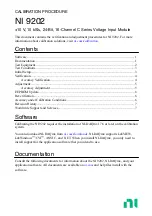
TST-019 MRTALPCH CHANNEL
– Rev. 2016-310
Page 2 of 20
Please note that the information gathered when performing a vacuum test is only valid if the tools
used to perform the test are accurate. Be sure that the tools you use are capable of completely
sealing the isolated parts of your system when tested. Recommended tools, in addition to an
appropriate test surface, are plugs for hoses and fittings, a ball valve with vacuum gauge attached,
push-in and barbed hose adapters and extra vacuum hose of the required sizes. This procedure is
written with the assumption that you have access to the appropriate tools.
If needed, test equipment is available from Wood’s Powr-Grip Co. To find out what is available,
contact a WPG Technical Sales Representative for additional information.
A set of screwdrivers may also be needed if the valve enclosure or pump cover needs to be
removed. Note: Always proceed with caution when removing the covers. Since wiring and hoses
may be connected to components in the cover, gentle removal is recommended so as not to
damage the attached components.
When removing a hose from a barbed fitting, take care to avoid damaging the barbs of the fitting to
which the hose is attached. Cuts or nicks in fitting barbs can create a leak that did not previously
exist. Additionally, if a hose is removed from a barbed fitting, cut approximately 1/8"-1/4" [3-6 mm]
off the end of the hose before reinstalling it on the fitting, in order to remove damaged hose ends.
For push-in fittings, the hose end must be cut square and straight to seal properly. To remove a
hose from a push-in fitting press the locking collar in towards the fitting and pull out on the hose. If a
hose is removed from a push-in fitting, cut approximately 1/8" [3 mm] off the end of the hose before
reinstalling it on the fitting, in order to remove damaged hose ends and to provide a fresh point of
contact for the locking collar. When installing a hose in a push-in fitting, push the hose in firmly and
then gently pull outward on the hose to ensure that it is fully secured (the hose should not pull out).
Additionally, when a hose is installed in a push-in fitting, it needs to run reasonably straight out from
the fitting, with minimal sideways pressure on the hose locking collar, to reduce the chance of a
vacuum leak.
Note: The vacuum system of this model lifter provides release using a “blow off” feature. This is
where the pressure side of the vacuum pump is plumbed to the control valve and pumps air into the
pad system when release mode is engaged, to help speed the release of the vacuum pads. When
testing the lifter for leaks, it is often necessary to seal off the system in some manner (cap off or plug
fittings and/or plug lines). Due to this, the use of the release function is not recommended during
the repair process, as it will cause pressure to build in the sealed-off section and may damage
components.





































